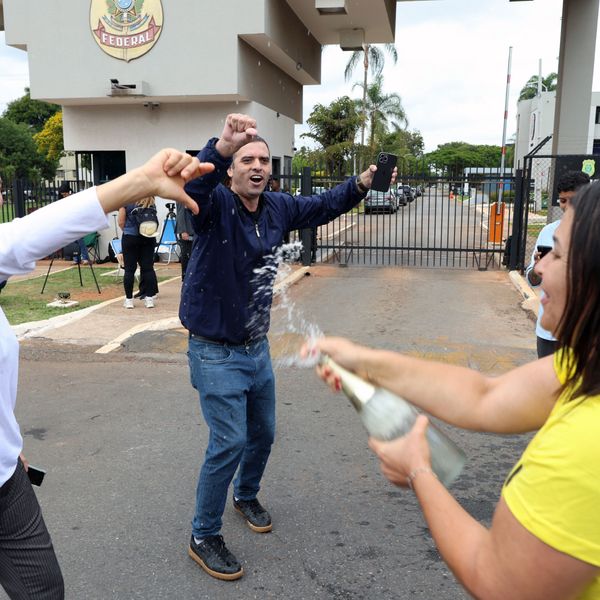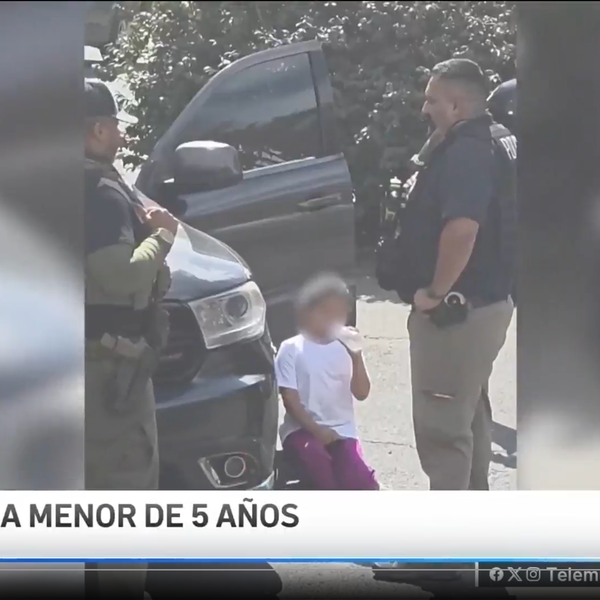Evidence Mounts Agent Provocateurs Used by Brazilian Police
Demonstrators say police infiltrator threw the molotov cocktail used to justify severe police violence
Police sent infiltrators and agent provocateurs into crowds of protesters in Rio de Janeiro Monday--the first day of the Pope's visit to Brazil-- as extensive video footage and witness testimony strongly suggests.
One of the two suspected infiltrators captured on film may have thrown the Molotov cocktail that was used as pretext for police to charge on hundreds of demonstrators with water cannons, tear gas, and rubber bullets and attack protesters and journalists alike with blunt force objects.
Military police released a video shortly after the police crackdown, allegedly showing that the repression was a direct response to protesters' violence. Yet, the video was mysteriously removed when photo and video evidence emerged suggesting that the person pictured throwing the Molotov cocktail, and his associate, were police officers.
The Lede blog of the New York Times compiles extensive video evidence from journalists and demonstrators that suggests the presence of at least two police infiltrators.
One clip, recorded by a witness, shows, "the two men were briefly stopped by a uniformed officer who seemed to take them for protesters before one of them pulled out some form of identification and said, "It's the police, dude."" the Lede reports. The footage can be seen here:
FLAGRANTE: Policiais infiltrados são confundidos com manifestantes pela PMERJPoliciais infiltrados (P2) causam tumulto ao passar pelo meio da própria polícia militar, não sendo previamente reconhecidos ...
While the Lede says there is "little doubt" that video evidence shows at least two infiltrators, it claims there is insufficient evidence to prove that the Molotov cocktail was thrown by one of them. However, Brazilian activists compiled evidence they say shows that the Molotov thrower was an agent provocateur, including an annotated video by a Brazilian blogger.
Police appeared to target journalists and videographers who were recording Monday's events, bludgeoning the head of an AFP photographer and arresting at least two journalists with the Midia Ninja media collective.
In an online statement, one of the Midia Ninja journalists who was arrested said that protesters rallied outside of the police station to support those on the inside, and the outpouring of solidarity left him "with the confidence that tomorrow will be greater."
Demonstrators were protesting the $53 million allocated towards funding the Pope's visit at a time when public services are being gutted and unemployment and poverty plaguing the country.
Mass mobilizations throughout Brazil--touched off by a March bus fare hike that swelled anger about diversion of public resources towards mass spectacles, like soccer matches and Pope visits, rather than vital services--have been met with severe police violence, and images of gas attacks on unarmed protesters have gone viral.
The tactic of sending police agent provocateurs into protests and communities to justify repression and violence is employed by police departments across the world, and is prevalent in the US.
An Urgent Message From Our Co-Founder
Dear Common Dreams reader, The U.S. is on a fast track to authoritarianism like nothing I've ever seen. Meanwhile, corporate news outlets are utterly capitulating to Trump, twisting their coverage to avoid drawing his ire while lining up to stuff cash in his pockets. That's why I believe that Common Dreams is doing the best and most consequential reporting that we've ever done. Our small but mighty team is a progressive reporting powerhouse, covering the news every day that the corporate media never will. Our mission has always been simple: To inform. To inspire. And to ignite change for the common good. Now here's the key piece that I want all our readers to understand: None of this would be possible without your financial support. That's not just some fundraising cliche. It's the absolute and literal truth. We don't accept corporate advertising and never will. We don't have a paywall because we don't think people should be blocked from critical news based on their ability to pay. Everything we do is funded by the donations of readers like you. Will you donate now to help power the nonprofit, independent reporting of Common Dreams? Thank you for being a vital member of our community. Together, we can keep independent journalism alive when it’s needed most. - Craig Brown, Co-founder |
Police sent infiltrators and agent provocateurs into crowds of protesters in Rio de Janeiro Monday--the first day of the Pope's visit to Brazil-- as extensive video footage and witness testimony strongly suggests.
One of the two suspected infiltrators captured on film may have thrown the Molotov cocktail that was used as pretext for police to charge on hundreds of demonstrators with water cannons, tear gas, and rubber bullets and attack protesters and journalists alike with blunt force objects.
Military police released a video shortly after the police crackdown, allegedly showing that the repression was a direct response to protesters' violence. Yet, the video was mysteriously removed when photo and video evidence emerged suggesting that the person pictured throwing the Molotov cocktail, and his associate, were police officers.
The Lede blog of the New York Times compiles extensive video evidence from journalists and demonstrators that suggests the presence of at least two police infiltrators.
One clip, recorded by a witness, shows, "the two men were briefly stopped by a uniformed officer who seemed to take them for protesters before one of them pulled out some form of identification and said, "It's the police, dude."" the Lede reports. The footage can be seen here:
FLAGRANTE: Policiais infiltrados são confundidos com manifestantes pela PMERJPoliciais infiltrados (P2) causam tumulto ao passar pelo meio da própria polícia militar, não sendo previamente reconhecidos ...
While the Lede says there is "little doubt" that video evidence shows at least two infiltrators, it claims there is insufficient evidence to prove that the Molotov cocktail was thrown by one of them. However, Brazilian activists compiled evidence they say shows that the Molotov thrower was an agent provocateur, including an annotated video by a Brazilian blogger.
Police appeared to target journalists and videographers who were recording Monday's events, bludgeoning the head of an AFP photographer and arresting at least two journalists with the Midia Ninja media collective.
In an online statement, one of the Midia Ninja journalists who was arrested said that protesters rallied outside of the police station to support those on the inside, and the outpouring of solidarity left him "with the confidence that tomorrow will be greater."
Demonstrators were protesting the $53 million allocated towards funding the Pope's visit at a time when public services are being gutted and unemployment and poverty plaguing the country.
Mass mobilizations throughout Brazil--touched off by a March bus fare hike that swelled anger about diversion of public resources towards mass spectacles, like soccer matches and Pope visits, rather than vital services--have been met with severe police violence, and images of gas attacks on unarmed protesters have gone viral.
The tactic of sending police agent provocateurs into protests and communities to justify repression and violence is employed by police departments across the world, and is prevalent in the US.
Police sent infiltrators and agent provocateurs into crowds of protesters in Rio de Janeiro Monday--the first day of the Pope's visit to Brazil-- as extensive video footage and witness testimony strongly suggests.
One of the two suspected infiltrators captured on film may have thrown the Molotov cocktail that was used as pretext for police to charge on hundreds of demonstrators with water cannons, tear gas, and rubber bullets and attack protesters and journalists alike with blunt force objects.
Military police released a video shortly after the police crackdown, allegedly showing that the repression was a direct response to protesters' violence. Yet, the video was mysteriously removed when photo and video evidence emerged suggesting that the person pictured throwing the Molotov cocktail, and his associate, were police officers.
The Lede blog of the New York Times compiles extensive video evidence from journalists and demonstrators that suggests the presence of at least two police infiltrators.
One clip, recorded by a witness, shows, "the two men were briefly stopped by a uniformed officer who seemed to take them for protesters before one of them pulled out some form of identification and said, "It's the police, dude."" the Lede reports. The footage can be seen here:
FLAGRANTE: Policiais infiltrados são confundidos com manifestantes pela PMERJPoliciais infiltrados (P2) causam tumulto ao passar pelo meio da própria polícia militar, não sendo previamente reconhecidos ...
While the Lede says there is "little doubt" that video evidence shows at least two infiltrators, it claims there is insufficient evidence to prove that the Molotov cocktail was thrown by one of them. However, Brazilian activists compiled evidence they say shows that the Molotov thrower was an agent provocateur, including an annotated video by a Brazilian blogger.
Police appeared to target journalists and videographers who were recording Monday's events, bludgeoning the head of an AFP photographer and arresting at least two journalists with the Midia Ninja media collective.
In an online statement, one of the Midia Ninja journalists who was arrested said that protesters rallied outside of the police station to support those on the inside, and the outpouring of solidarity left him "with the confidence that tomorrow will be greater."
Demonstrators were protesting the $53 million allocated towards funding the Pope's visit at a time when public services are being gutted and unemployment and poverty plaguing the country.
Mass mobilizations throughout Brazil--touched off by a March bus fare hike that swelled anger about diversion of public resources towards mass spectacles, like soccer matches and Pope visits, rather than vital services--have been met with severe police violence, and images of gas attacks on unarmed protesters have gone viral.
The tactic of sending police agent provocateurs into protests and communities to justify repression and violence is employed by police departments across the world, and is prevalent in the US.

